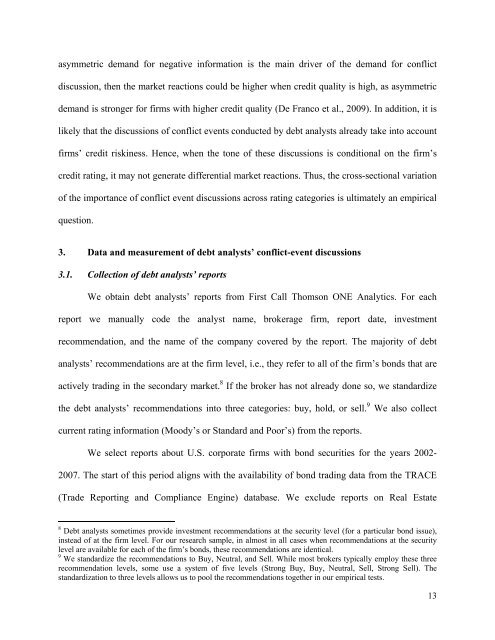Debt Analysts' Views of Debt-Equity Conflicts of Interest
Debt Analysts' Views of Debt-Equity Conflicts of Interest
Debt Analysts' Views of Debt-Equity Conflicts of Interest
Create successful ePaper yourself
Turn your PDF publications into a flip-book with our unique Google optimized e-Paper software.
asymmetric demand for negative information is the main driver <strong>of</strong> the demand for conflict<br />
discussion, then the market reactions could be higher when credit quality is high, as asymmetric<br />
demand is stronger for firms with higher credit quality (De Franco et al., 2009). In addition, it is<br />
likely that the discussions <strong>of</strong> conflict events conducted by debt analysts already take into account<br />
firms’ credit riskiness. Hence, when the tone <strong>of</strong> these discussions is conditional on the firm’s<br />
credit rating, it may not generate differential market reactions. Thus, the cross-sectional variation<br />
<strong>of</strong> the importance <strong>of</strong> conflict event discussions across rating categories is ultimately an empirical<br />
question.<br />
3. Data and measurement <strong>of</strong> debt analysts’ conflict-event discussions<br />
3.1. Collection <strong>of</strong> debt analysts’ reports<br />
We obtain debt analysts’ reports from First Call Thomson ONE Analytics. For each<br />
report we manually code the analyst name, brokerage firm, report date, investment<br />
recommendation, and the name <strong>of</strong> the company covered by the report. The majority <strong>of</strong> debt<br />
analysts’ recommendations are at the firm level, i.e., they refer to all <strong>of</strong> the firm’s bonds that are<br />
actively trading in the secondary market. 8 If the broker has not already done so, we standardize<br />
the debt analysts’ recommendations into three categories: buy, hold, or sell. 9 We also collect<br />
current rating information (Moody’s or Standard and Poor’s) from the reports.<br />
We select reports about U.S. corporate firms with bond securities for the years 2002-<br />
2007. The start <strong>of</strong> this period aligns with the availability <strong>of</strong> bond trading data from the TRACE<br />
(Trade Reporting and Compliance Engine) database. We exclude reports on Real Estate<br />
8 <strong>Debt</strong> analysts sometimes provide investment recommendations at the security level (for a particular bond issue),<br />
instead <strong>of</strong> at the firm level. For our research sample, in almost in all cases when recommendations at the security<br />
level are available for each <strong>of</strong> the firm’s bonds, these recommendations are identical.<br />
9 We standardize the recommendations to Buy, Neutral, and Sell. While most brokers typically employ these three<br />
recommendation levels, some use a system <strong>of</strong> five levels (Strong Buy, Buy, Neutral, Sell, Strong Sell). The<br />
standardization to three levels allows us to pool the recommendations together in our empirical tests.<br />
13
















